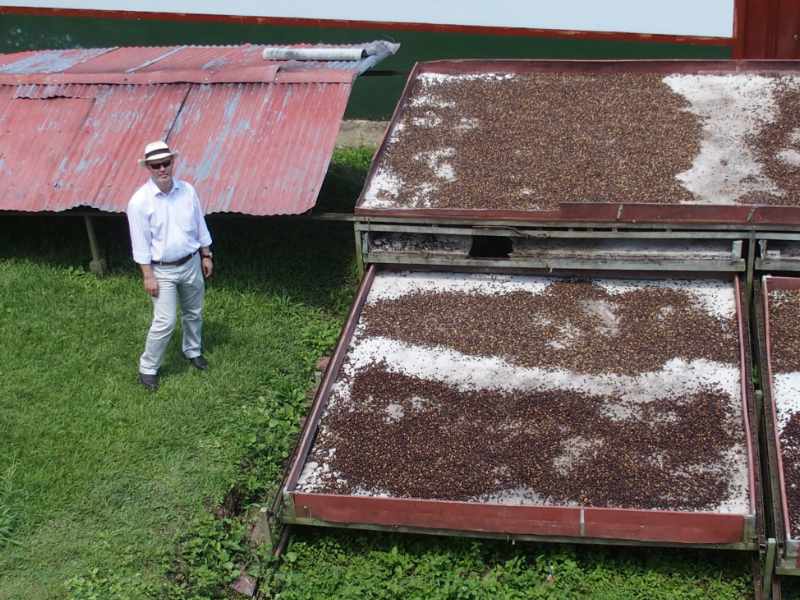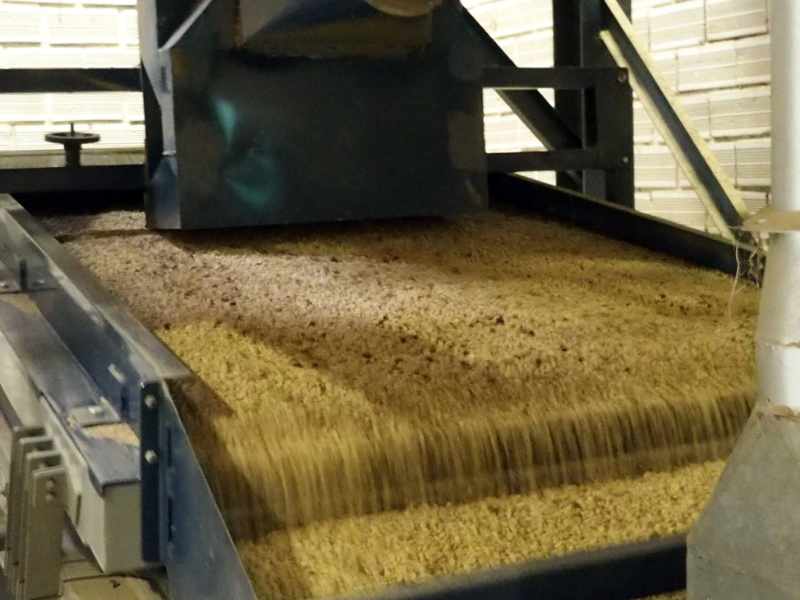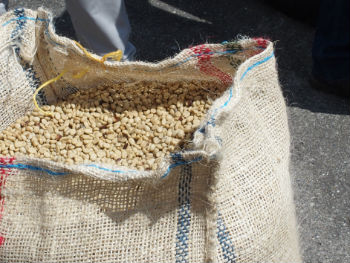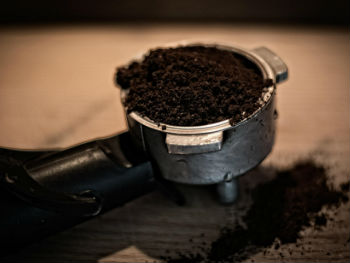COFFEE 🔼
cof·fee /ˈkôfē,ˈkäfē/ noun The berries harvested from species of Coffea plants. In the commercial coffee industry, there are two important coffee species — Arabica and Robusta. (1). Coffea Arabica — C. Arabica :- Coffea Arabica is descended from the original
coffee trees discovered in Ethiopia. These trees produce a fine, mild,
aromatic coffee and represent approximately 70% of the world's coffee
production. The beans are flatter and more elongated than Robusta and
lower in caffeine. On the world market, Arabica coffees bring the highest prices. (2). Coffea canephora — var. Robusta :- Most of the world's Robusta is grown in Central and
Western Africa, parts of Southeast Asia, including Indonesia and
Vietnam, and in Brazil. Production of Robusta is increasing, though it
accounts for only about 30% of the world market. Robusta is primarily used in blends and for instant
coffees. The Robusta bean itself tends to be slightly rounder and
smaller than an Arabica bean. Robusta beans produce a coffee which has a distinctive taste and about 50-60% more caffeine.
🔺 The Anatomy of a Coffee Cherry :
The beans you brew are actually the processed and roasted seeds from a fruit, which is called a coffee cherry.
🔺 History :
🔺 10 Steps from Seed to Cup :
The coffee you enjoy each day has taken a long journey to arrive in your cup.
1. Planting :-
A coffee bean is actually a seed. When dried, roasted and ground, it’s
used to brew coffee. If the seed isn’t processed, it can be planted and
grow into a coffee tree.
2. Harvesting the Cherries :-
Depending on the variety, it will take approximately 3 to 4 years for
the newly planted coffee trees to bear fruit. The fruit, called the
coffee cherry, turns a bright, deep red when it is ripe and ready to be
harvested.
3. Processing the Cherries :-
The Dry Method is the age-old method of processing
coffee, and still used in many countries where water resources are
limited. The freshly picked cherries are simply spread out on huge
surfaces to dry in the sun.
The Wet Method removes the pulp from the coffee cherry
after harvesting so the bean is dried with only the parchment skin left
on. First, the freshly harvested cherries are passed through a pulping
machine to separate the skin and pulp from the bean.
When fermentation is complete, the beans feel rough to the touch. The
beans are rinsed by going through additional water channels, and are
ready for drying.
4. Drying the Beans :-
 If
the beans have been processed by the wet method, the pulped and
fermented beans must now be dried to approximately 11% moisture to
properly prepare them for storage.
If
the beans have been processed by the wet method, the pulped and
fermented beans must now be dried to approximately 11% moisture to
properly prepare them for storage.
5. Milling the Beans :-

Before being exported, parchment coffee is processed in the following manner:
Hulling machinery removes the parchment layer (endocarp) from wet processed coffee. Hulling dry processed coffee refers to removing the entire dried husk — the exocarp, mesocarp and endocarp — of the dried cherries.
Polishing is an optional process where
any silver skin that remains on the beans after hulling is removed by
machine. While polished beans are considered superior to unpolished
ones, in reality, there is little difference between the two.
Grading and Sorting is done by size and weight, and beans are also reviewed for color flaws or other imperfections.
Beans are sized by being passed through a series of
screens. They are also sorted pneumatically by using an air jet to
separate heavy from light beans. Finally, defective beans are removed either by hand or by machinery.
6. Exporting the Beans :-
 The milled beans, now referred to as green coffee, are loaded onto ships in either jute or sisal bags.
The milled beans, now referred to as green coffee, are loaded onto ships in either jute or sisal bags.
7. Tasting the Coffee :-
Coffee is repeatedly tested for quality and taste. This process is referred to as cupping and usually takes place in a room specifically designed to facilitate the process. An expert cupper can taste hundreds of samples of coffee a day and still taste the subtle differences between them.
8. Roasting the Coffee :-
Roasting transforms green coffee into the aromatic brown
beans that we purchase in our favorite stores or cafés. Most roasting
machines maintain a temperature of about 550 degrees Fahrenheit. The
beans are kept moving throughout the entire process to keep them from
burning.
When they reach an internal temperature of about 400 degrees Fahrenheit, they begin to turn brown and the caffeol, a fragrant oil locked inside the beans, begins to emerge. This process called pyrolysis is at the heart of roasting — it produces the flavor and aroma of the coffee we drink.
After roasting, the beans are immediately cooled either by air or water.
9. Grinding Coffee :-
 The
objective of a proper grind is to get the most flavor in a cup of
coffee. How coarse or fine the coffee is ground depends on the brewing
method.
The
objective of a proper grind is to get the most flavor in a cup of
coffee. How coarse or fine the coffee is ground depends on the brewing
method.
That’s why coffee ground for an espresso machine is much finer than coffee brewed in a drip system. Espresso machines use 132 pounds per square inch of pressure to extract coffee.
10. Brewing Coffee :-
Try to enjoy your coffee as thoughtfully as it was prepared - take in the aroma, and notice the flavors in each sip.
🔺 Coffee and Health :
the highlights of scientific research and evidence of coffee’s unique health benefits related to:
1). Longevity
2). Cancer
3). Diabetes
4). Cardiovascular disease
5). Stroke
6). Liver and kidney health
7). Mental health
1). Coffee & Longevity :-
SCIENCE: In a review of 21 prospective studies totaling over 10 million participants, drinking one cup of coffee (whether decaf or with caffeine) per day was associated with a 3% reduced risk of death, and drinking 3 cups of coffee was associated with a 13% reduced risk of death.
SOURCE: Caffeinated and decaffeinated coffee consumption and risk of all-cause mortality: a dose-response meta-analysis of cohort studies by Li et al., Journal of Human Nutrition and Dietetics
SCIENCE: A study from the International Agency for Research on Cancer (IARC) looked at over 500,000 people, and found that drinking coffee, whether decaf or with caffeine, was associated with reduced risk for death from various causes.
SOURCE: ‘Coffee Drinking and Mortality in 10 European Countries: A Multinational Cohort Study’ by Gunter et al in Annals of Internal Medicine (2017) [Funded by IARC]
SCIENCE: A study of over 500,000 people, spanning a decade, found that drinking coffee, whether caffeinated or decafeinated, was inversely associated with mortality, including among those drinking 8 or more cups per day.
SOURCE: ‘Association of Coffee Drinking with Mortality by Genetic Variation in Caffeine Metabolism’ by Loftfield, Cornelis, Caporaso, Yu, Sinha and Freedman, in JAMA Intern Med (2018)
SCIENCE: In a large study looking at over 400,000 people, coffee consumption was associated with lower likelyhood of death from disease.
SOURCE: ‘Association of Coffee Drinking with Total and Cause-Specific Mortality’ by Freedman, Park, Abnet, Hollenbeck and Sinha in The New England Journal of Medicine (2012)
2). Coffee & Cancer :-
SCIENCE: A meta analysis of human prospective studies showed that drinking both caffeinated and decaffeinated coffee was associated with reduced risk of liver cancer.
SOURCE: Coffee, including caffeinated and decaffeinated coffee, and the risk of hepatocellular carcinoma: a systematic review and dose–response meta-analysis by Kennedy OJ, Roderick P, Buchanan R, et al, BMJ Open
SCIENCE: Coffee drinking is associated with a lower risk of colon cancer in women. A study showed that there was a 20% reduced risk of colon cancer in women who drank more htan 3 cups of coffee day, compared to those who drank less than one or less.
SOURCE: Coffee drinking and colorectal cancer and its sub-sites: a pooled analysis of 8 cohort studies in Japan by Kashino, et al. for the Research Group for the Development and Evaluation of Cancer Prevention Strategies in Japan (2018)
SCIENCE: Drinking coffee may prevent recurrence of liver cancer in adults
SOURCE: ‘Protective effects of coffee consumption following liver transplantation for hepatocellular carcinoma’ by Wiltberger, Lange, et al, in Zeitschrift fur Gastroenterologie (2018)
3). Coffee & Diabetes :-
SCIENCE: Studies show that coffee drinkers are at a lower risk of developing Type 2 diabetes, which accounts for 90-95% of diabetes cases in the world. They also show that people who drink four or more cups of coffee daily have a 50% lower risk of Type 2 diabetes.
SOURCE: ‘Coffee components inhibit amyloid formation of human islet amyloid polypeptide in vitro: possible link between coffee consumption and diabetes/ by Cheng et al, in the Journal of Agricultural and Food Chemistry (2011)
SCIENCE: Cafestol, a compound found in coffee, could help to stave off type 2 diabetes. The compound has been found to increase insulin secretion, reduce fasting glucose levels and improve insulin sensitivity in mice.
SOURCE: ‘Cafestol, a bioactive substance in coffee, has anti-diabetic properties in KKAy mice’ by Mellbye et al, in the Journal of Natural Products (2017)
4). Coffee & Stroke :-
SCIENCE: The results of a survey looking at over 83,000 women over many years showed that coffee consumption may modestly reduce the risk of stroke among women.
SOURCE: ‘Coffee consumption and risk of stroke in women’ by Lopez-Garcia et al, in Circulation: Journal of the American Heart Association (2009)
SCIENCE: A study from the International Agency for Research on Cancer looked at over 500,000 people, and found that coffee drinking was associated with reduced risk for death from various causes, including stroke.
SOURCE: ‘Coffee Drinking and Mortality in 10 European Countries: A Multinational Cohort Study’ by Gunter et al in Annals of Internal Medicine (2017) [Funded by IARC]
SCIENCE: A large-scale study in Japan found that higher green tea and coffee consumption was inversely associated with risk of CVD and stroke in the general population.
SOURCE: The impact of green tea and coffee consumption on the reduced risk of stroke incidence in Japanese population’ by Kobubo et al, in Stroke (2013)
5). Coffee & Kidney Health :-
SCIENCE: Coffee consumption is associated with reduced risk of chronic kidney disease.
SOURCE: 'Effect of Coffee Consumption on Renal Outcome: A Systematic Review and Meta-Analysis of Clinical Studies' by Kanbay M, Siriopol D, Copur S, Tapoi L, et al. Journal of Renal Nutrition (2020).
6). Coffee & Mental Health :-
SCIENCE: An independant meta-analysis found that coffee consumption is associated with a reduced risk of depression.
SOURCE: 'Coffee Drinkers Are Less Likely Than Others to be Depressed -- a Review of Current Research on Coffee, Depression and Depressive Sympoms' by Dr. Alan Leviton, Harvard Medical School.
🔺 Benefits of Coffee - Synopsis :
1. Coffee drinkers live longer, healthier, happier lives.
2. Coffee drinkers live longer than non coffee drinkers.
3. Coffee as the number one source of antioxidants in the US diet.
4. Coffee may help lower the risk of getting certain cancers.
5. Coffee is good for the economy.
The coffee industry is critically important to the US economy. In the US, coffee- directly or indirectly- accounts for over 1.6m jobs with wage compensation of $58.08bn.
In 2015, coffee represented $220.98bn of the US economic output i.e. 1.2% of US GDP. That is more than 4bn every week or 605m every day.
The coffee industry brought in $27bn in taxes at Federal, State and Local level in 2015. Around 125 million people worldwide depend on coffee for their livelihoods. Coffee is the most valuable and widely traded tropical agricultural product.
🔺 Nutrition :
Coffee is Source Of :-
1. Caffeine
2. Vitamin B2 (riboflavin)
3. Magnesium
4. Plant chemicals: polyphenols including chlorogenic acid and quinic acid, and diterpenes including cafestol and kahweol
One 8-ounce cup of brewed coffee contains about 95 mg of caffeine. A moderate amount of coffee is generally defined as 3-5 cups a day, or on average 400 mg of caffeine, according to the Dietary Guidelines for Americans.
🔺 Know Please :
1. It is a myth that darker roasts contain a higher level of caffeine than lighter roasts. Lighter roasts actually have a slightly higher concentration!
2. Coffee grinds should not be brewed more than once. Brewed grinds taste bitter and may no longer produce a pleasant coffee flavor.
3. While water is always the best choice for quenching your thirst, coffee can count towards your daily fluid goals. Although caffeine has a mild diuretic effect, it is offset by the total amount of fluid from the coffee.
4. Recommended Amounts of Caffeine :
Caffeine
is naturally found in the fruit, leaves, and beans of coffee, cacao,
and guarana plants. It is also added to beverages and supplements.
In the U.S., adults consume an average of 135 mg of caffeine daily,
or the amount in 1.5 cups of coffee (1 cup = 8 ounces). [5] The U.S.
Food and Drug Administration considers 400 milligrams (about 4 cups
brewed coffee) a safe amount of caffeine for healthy adults to consume
daily. However, pregnant women should limit their caffeine intake to 200
mg a day (about 2 cups brewed coffee), according to the American
College of Obstetricians and Gynecologists.
The American Academy of Pediatrics suggests that children under age
12 should not consume any food or beverages with caffeine. For
adolescents 12 and older, caffeine intake should be limited to no more
than 100 mg daily. This is the amount in two or three 12-ounce cans of
cola soda.
🔺 Espresso :
Espresso (ess-PRESS-oh) is a full-flavored, concentrated form of coffee
that is served in “shots.” It is made by forcing pressurized hot water
through very finely ground coffee beans using an espresso machine. The
result is a liquid stronger than coffee topped with a "crema", a
brown foam that forms when air bubbles combine with the soluble oils of
fine-ground coffee and sits on top of a properly pulled shot of
espresso. The crema adds to the rich flavor and lingering aftertaste of
espresso.
- Origin: Italy
- Temperature: 190°F
- Caffeine: 29-100 mg per shot
- Main Ingredient: ground coffee beans
🔺 Barista :
A barista ( from the Italian/Spanish for "bartender") is a person, usually a coffeehouse employee, who prepares and serves expresso-based coffee drinks.
A barista is a person who prepares and also generally serves espresso-based coffee drinks. In the United States, the term barista is also often applied to coffee shop employees who prepare both espresso and regular coffee drinks.
🔺 Macchiato :
In Italian, the term "macchiato" translates as "marked" or "stained", meaning a stained or marked coffee. The macchiato is an espresso coffee drink, topped with a small amount of foamed or steamed milk to allow the taste of the espresso to still shine through.
Cappuccinos are made using equal parts espresso, steamed milk, and milk foam, while lattes involve adding steamed milk to an espresso. Meanwhile, macchiatos are made by adding a splash of milk to a shot of espresso.
The only milk found in a macchiato is steamed milk. Whereas a latte has a combination of steamed milk and a layer of foamed milk on top. It often comes with a bit of added cream on top too. Macchiatos are more common among the two in Italy.
FAQs : Coffee
1. How healthy is coffee for you?
Ans:- “For most people, moderate coffee consumption can be incorporated into a healthy diet.” Hu said that moderate coffee intake—about 2–5 cups a day—is linked to a lower likelihood of type 2 diabetes, heart disease, liver and endometrial cancers, Parkinson's disease, and depression.
2. Why coffee is important?
Ans:- The caffeine in coffee has been found in animal and cell studies to protect cells in the brain that produce dopamine. In a large prospective cohort of more than 500,000 people followed for 10 years, an association was found between drinking higher amounts of coffee and lower rates of death from all causes.
3. Is coffee good for your hair?
Ans:- Coffee is rich in a whole lot of nutrients and vitamins that are good for your hair in more ways than one. Studies have shown that caffeine has the ability to stimulate and boost hair growth, reduce hair loss, and make hair thicker and longer.
4. What are the health benefits of coffee?Ans:- Here are the top ways coffee can positively impact your health :
* Your body may process glucose (or sugar) better.
* You're less likely to develop heart failure.
* You are less likely to develop Parkinson's disease.
* Your liver will thank you.
* Your DNA will be stronger.
5. How much coffee is OK for health?
Ans:- For healthy adults, the FDA has cited 400 milligrams a day—that's about four or five cups of coffee—as an amount not generally associated with dangerous, negative effects.
6. Is milk coffee good for health?
Ans:- Coffee with milk contains a good amount of protein, carbohydrates, and fats which helps in maintaining bone health and provides the body with the required amount of calcium.
7. Why is coffee important to the world?Ans:- Whether it be for energy, socialization, or tradition, the cultivation of coffee has served as a motivating force of the world. The modernization of coffee and its unique forms across cultures are markers of tradition and modern changes across continents.
8. Why is coffee important in society?Ans:- Long term use of coffee, in particular, is even shown to lower your risk of diseases, such as cardiovascular disease or neurological issues. Due to how coffee improves alertness, it's even linked to improved cognitive function. The mood-boosting effects of coffee also make people happier in the long run.
9. Is mixing coffee with shampoo good for hair?
Ans:- It gives natural shine and luster to your tresses without damaging them. It darkens your hair color, thereby adding natural tint and enhancing the texture of your hair. It is a good scalp treatment. Coffee can be added to any hair pack, shampoo, or conditioner to increase its effectiveness.
10. Can we use Bru coffee for hair?
Ans:- Yes, you can add any organic coffee powder in your shampoo. This practice can help stimulate your scalp and help make your hair grow faster.
11. How often can I use coffee on my hair?
Ans:- The caffeine in coffee blocks a hormone that causes hair loss and allows your hair to remain in its growth cycle longer than normal. Try using coffee grounds once or twice a week.
12. How often can I use coffee on my hair?
Ans:- The caffeine in coffee blocks a hormone that causes hair loss and allows your hair to remain in its growth cycle longer than normal. Try using coffee grounds once or twice a week.
13. Is espresso a coffee or alcohol?Ans:- Espresso is a concentrated form of coffee served in small, strong shots and is the base for many coffee drinks. It's made from the same beans as coffee but is stronger, thicker, and higher in caffeine.
14. What is an espresso?
Ans:- Espresso is a concentrated form of coffee, served in shots. It's made of two ingredients - finely ground, 100% coffee, and hot water.
15. Is espresso stronger than other coffee?
Ans:- Espresso typically has 63 mg of caffeine in 1 ounce (the amount in one shot), according to Department of Agriculture nutrition data. Regular coffee, by contrast, has 12 to 16 mg of caffeine in every ounce, on average. That means that ounce for ounce, espresso has more caffeine.
16. What is be called barista?
Ans:- A barista is a person who prepares and also generally serves espresso-based coffee drinks. In the United States, the term barista is also often applied to coffee shop employees who prepare both espresso and regular coffee drinks.
17. What does a barista do?
Ans:- A Barista is a professional who makes and serves beverages such as coffee, tea and specialty beverages. They are responsible for taking customer orders and payments. They also clean and sanitize their work areas, seating areas and equipment/tools.
18. Where is the Indian Barista company H.O?
Ans:- It is headquartered in New Delhi, India, and maintains outlets across India, and in other regional countries such as Sri Lanka, and Maldives.
19. What's the difference between a macchiato and a latte?
Ans:- The only milk found in a macchiato is steamed milk. Whereas a latte has a combination of steamed milk and a layer of foamed milk on top. It often comes with a bit of added cream on top too. Macchiatos are more common among the two in Italy.
20. Is a macchiato mostly coffee?
Ans:- A macchiato is a stronger coffee offering bold flavours than latte and cappuccino. Its main ingredients are single or double-shot of espresso and a dollop of milk. The macchiato tastes like espresso the only difference is the hint of milk put on the Macchiato.
21. What goes in a macchiato?
Ans:- For a Hot Macchiato, a rich and bold espresso beverage, we add a layer of steamed milk, topped with two shots of espresso, then finished with milk foam.
22. What is macchiato vs cappuccino?Ans:- Cappuccinos are made using equal parts espresso, steamed milk, and milk foam, while lattes involve adding steamed milk to an espresso. Meanwhile, macchiatos are made by adding a splash of milk to a shot of espresso.
 If
the beans have been processed by the wet method, the pulped and
fermented beans must now be dried to approximately 11% moisture to
properly prepare them for storage.
If
the beans have been processed by the wet method, the pulped and
fermented beans must now be dried to approximately 11% moisture to
properly prepare them for storage.
 The milled beans, now referred to as green coffee, are loaded onto ships in either jute or sisal bags.
The milled beans, now referred to as green coffee, are loaded onto ships in either jute or sisal bags.  The
objective of a proper grind is to get the most flavor in a cup of
coffee. How coarse or fine the coffee is ground depends on the brewing
method.
The
objective of a proper grind is to get the most flavor in a cup of
coffee. How coarse or fine the coffee is ground depends on the brewing
method.

